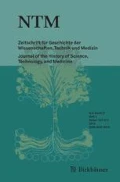Abstract
The science of aerodynamics was in a desolate state around the turn of the century. Phenomena like resistance or updrift in a flow were known and studied, but not understood properly. The theoretical understanding was still dominated by the Newtonian resistance theory, which had already proved insufficient since the 18th century. The Danish scientists Hans Christian Vogt, Johan Irminger and Poul la Cour provided significant contributions to aerodynamics around the turn of the century and belonged to the first to break with the traditional understanding. Vogt studied a large variety of natural aerodynamic phenomena like the flight of birds or the movement of fishes. He recognized that updrift and resistance are interrelated phenomena and explained updrift by a reduced air pressure on the upper side of a wing, fin or blade. His friend Johan Irminger provided careful measurements of the air pressure around a body in an air flow, which confirmed Vogts ideas. Poul la Cour made even more precise measurements in a wind tunnel and provided the best experimental understanding of aerodynamic phenomena hitherto available. Based on his investigations he concluded the design features of an „ideal windmill”-which proved to be exactly those of the traditional windmill.
Similar content being viewed by others
Literature
Anderson, John D.:A History of Aerodynamics and its Impact on Flying Machines Cambridge, MA 1997.
Baker, T. Lindsay:A Field Guide to American Windmills. Norman 1985.
Betz, Albert: „Das Maximum der theoretisch möglichen Ausnützung des Windes durch Windmotoren”Zeitschrift für das gesamte Turbinenwesen 1920, S. 307–309.
Betz Albert:Wind-Energie und ihre Ausnutzung durch Windmühlen. Göttingen 1926.
Dubuat, L. G.:Principes d'hydrauliques, Zweite Ausgabe,, Bd. 2. Paris 1786.
Flachsbart, Otto: „Geschichte der experimentellen Hydro- und Aeromechanik, insbesondere der Widerstandsforschung”.Handbuch der Experimentalphysik Bd. IV, Teil 2, Ludwig Schiller (Hrsg.),Hydro- und Aerodynamik, Widerstand und Auftrieb. Leipzig 1932, S. 3–61.
Föttinger, Hermann: „Neue Grundlagen für die theoretische und experimentelle Behandlung des Propellerproblems”. Schiffsbautechnische Gesellschaft (Hrg.),Jahrbuch 1918, S. 385–487.
Hanle, Paul A.:Bringing Aerodynamics to America. Cambridge 1982.
Hansen, Hans Christian:Forsøgsmøllen i Askov, Poul la Cours Mølle. Kolding 1981.
Hansen, Hans Christian:Poul la Cour, Grundtvigianer, Opfinder og Folkeoplyser. Vejen 1985.
Heymann, Matthias:Die Geschichte der Windenergienutzung 1890–1990. Frankfurt a. M. 1995.
Heymann, Matthias: „Technisches Wissen, Orientierungen und Mentalitäten: Hintergründe zur Mißerfolgsgeschichte der Windenergietechnik im 20. Jahrhundert”.Technikgeschichte 63 (1996), H. 3, S. 237–254.
Heymann, Matthias: „Sighs of Hubris: The The shaping of wind technology styles in Germany, Denmark, and the USA, 1940–1990”.Technology and Culture 39 (1998), No. 4, S. 641–670.
Heymann, Matthias: „“Berge des Irrtums und der Unklarheit”: Aerodynamik und Windenergietechnik 1890–1925”. Ivo Schneider, Helmuth Trischler, Ulrich WengenrothWechselbeziehungen zwischen Naturwissenschaften und Technik. Erscheint, München 2000.
„Institution of Gas Engineers”,Ingeniøren 1899, S. 167.
Irminger, Johan: „Nogle forsøg over trykforholdene på, planer og legemer, påvirkede af luftstrømninger”Ingeniøren 1894, S. 101–105 und 107–109.
Irminger, Johan: „Experiments on wind-pressure”,Proceedings of the Instituteion of Civil Engineers, Institution of Gas Engineers. London 1893/94, S. 468.
Irminger, Johan: „Nogle bem≸rkninger om taget på Ribe Domkirke”.Ingeniøren 1904, S. 335–336.
Irminger, Johan: „fra aerodynamikkens første tid”.Ingeniøren 1935, S. 177.
Kármán, Theodore von:Aerodynamik, Ausgewählte Themen im Lichte der historischen Entwicklung. Genf 1956.
Koch, Hal:Grundtvig Leben u. Werk. Köln 1951. (Dänisches Original: Kopenhagen 1944).
König, Wolfgang: „Massenproduktion und Technikkonsum, Entwicklungslinien und Triebkräfte der Technik zwischen 1880 und 1914”,Propyläen-Technikgeschichte Bd. 4. Berlin 1990, S. 263–552.
Kutta, W. M.: „Über ebene Zirkulationsströmungen nebst flugtechnischer Anwendungen”,Sitzungsbericht der bayerischen Akademie der Wissenschaften, Sonderdruck. München 1911.
La Cour, Poul „Forsøg med små møllemodeller”.Ingeniøren 1897 S. 59–64.
La Cour, Poul:Die Windkraft und ihre Anwendung zum Antrieb von Elektrizitäts-Werken. Leipzig 1905. (Dänisches Original: Poul la Cour:Forsøgsmøllen I–II, Kopenhagen 1900; und ders:Forsøgsmøllen III–IV, Kopenhagen 1903).
Lanchester, Frederic W.:Aerodynamics. London 1907.
Langley, Samuel P.:Experiments in aerodynamics, Smithsonian contribution to knowledge. Washington 1891.
Lilienthal, Otto:Der Vogelflug als Grundlage der Fliegekunst, Ein Beitrag zur Systematik der Flugtechnik, 2. Aufl. München 1996. (Reprint der Originalausgabe von 1910).
„Nedstyrtningen af Louisville-Jeffersonville broen”.Ingeniøren 1894, S. 43–44.
Newton, Isaac:Philosophiae Naturalis Principia Mathematica. 1. Ausgabe 1687, lib. 2. sectio, 7, prop. 33, theor. 26.
Phillips, Horatio: „Experiments with currents of air”.Engineering 1885.
Putnam, Coslett Palmer:Power from the Wind. New York 1948.
Radkau, Joachim:Technik in Deutschland, Vom 18. Jahrhundert bis zur Gegenwart. Frankfurt a. M. 1989.
Rotta, Julius C.:Die Aerodynamische Versuchsanstalt in Göttingen, ein Werk Ludwig Prandtls. Göttingen 1990.
Schlichting, Hermann:Grenzschicht-Theorie. 3. Ausgabe, Karlsruhe 1958.
Vind, Ole:Tidlige Danske Bidrag til Aerodynamikken. Magisterarbeit. Kopenhagen 1972.
Vinding, Poul: „Nekrolog for Hans Christian Vogt”.Ingeniøren 1928, S. 157–158.
Vinding, Poul: „Johan Irminger”.Dansk teknik gennem 100 år. Kopenhagen 1941, S. 97–106.
Vogt, Hans Christian: „Aerodynamics”.Engineering 1892, S. 393f.
Vogt, Hans Christian: Om enheden i propelleres virkemøde.Den Tekniske Forenings Tidsskrift 1893/94, S. 15–19.
Vogt, Hans Christian: Om økonomisk fremdrift til søs.Den Tekniske Forenings Tidsskrift 1894/95, S. 193–198.
Vogt, Hans Christian: Om sugningsteorien.Ingeniøren 1895, S. 43 und 66.
Vogt, Hans Christian: „Pendulpropelleren”.Ingeniøren 1895, S. 147–150 und unter gleichem Titel:Ingeniøren 1899, S. 249f,Ingeniøren 1901, S. 131–136, 229–230, 397–399,Ingeniøren 1902, S. 297–301 und 307f,Ingeniøren 1905, S. 339.
Vogt, Hans Christian: „Besøg på Askov”.Ingeniøren 1896, S. 191–193.
Vogt, Hans Christian: Nogle Bem≸rkninger til prof. la Cours forsøg med møllemodeller.Ingeniøren 1897, S. 133f.
Vogt, Hans Christian: „Lidt om en fysisk fejltagelse”.Ingeniøren 1899, S. 57–60.
Wøldike, P.R.: „Om vind og bølger”; ders, „Om sugningsteorien”; ders. „Sugning contrastuvning”. alleIngeniøren 1895, S. 33–35, 61 und 79f.
Author information
Authors and Affiliations
Rights and permissions
About this article
Cite this article
Heymann, M. Vom albatros zur „idealen windmühle”: Zum vorsprung dänischer aerodynamik um die jahrhundertwende. NTM N.S. 8, 85–102 (2000). https://doi.org/10.1007/BF02914177
Issue Date:
DOI: https://doi.org/10.1007/BF02914177




